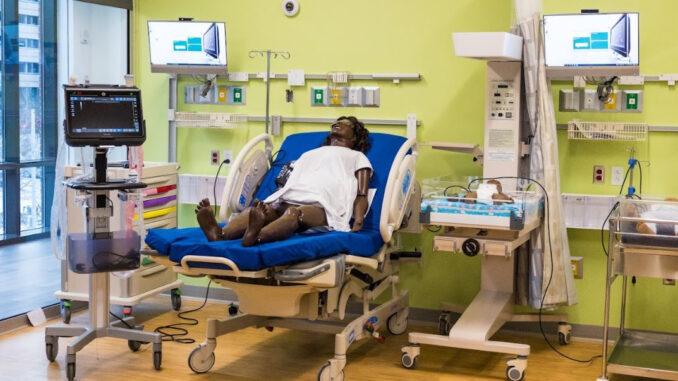
Ember Duke | Staff Writer
The long anticipated Duquesne University College of Osteopathic Medicine opened its doors for the first time on Jan. 17 to students, faculty and the public.
From the outside, it’s hard to imagine the spacious, modern five floors designed to give medical students a hands-on learning experience that lay beyond the school’s front doors. The open space, glass facade which allows for natural lighting and high ceilings of the entrance level will welcome students. On one floor there are also a large lecture auditorium and virtual reality lab. A stairwell in the middle of the lobby leads down to the Osteopathic Manipulative Medicine and Clinical Skills Lab which can house half of the program’s students at a time.
One of the prize learning features is the hospital simulation lab, meant to mimic the experiences and atmosphere of a real hospital. Access to equipment such as personal ultrasound machines and hired actors to imitate patient interactions will make class times interactive and realistic, John Kauffman, dean of the school, said.
“If we can take information and build it into a case, you’ll probably remember the clinical case better than just facts,” he said.
Osteopathic medicine is a newer approach that puts more emphasis on prevention of disease and lifestyle adjustments to aid wellbeing while still taking beneficial treatments from traditional practice. A large factor in this realm of study is in-depth knowledge of the musculo-skelatal system. Kauffman hopes the school of medicine will train new doctors to understand how to help the body heal itself.
“We work at treating the whole person’s mind, body and spirit,” Kauffman said. “That interconnectedness …We currently have a disease care system. We are very good at diagnosing and treating disease. We are not terribly good at preventing it. So the opportunity in medicine right now is to really focus on health, wellness and prevention.”
Olivia Volger, an upcoming doctoral student and current master’s of biomedical science student at Duquesne, is excited for the opportunities in and out of the classroom next fall.
“I think everyone here has such a good perspective on medicine and using those lifestyle factors and things that aren’t really huge in medicine right now like pushing exercise and nutrition,” she said. “I feel like the community here is just pushing for that change and helping underserved communities as well.”
Fellow incoming medical student Dina Silvestri was intrigued by the program’s approach to medicine.
“I think the opportunity to go and be interested in an osteopathic medical school was something that was very interesting,” Silvestri said. “I think the mission of community service was very attractive. I mean osteopathic medicine in and of itself is so different approach to holistic healthcare and full body treatment so it was just a really interesting opportunity.”
Looking towards her next few years of medical school, Silvestri said she’s excited to learn to be the best physician possible and serve the community.
“I interviewed with Dr. Traore [faculty of the medical school], who is from Africa and he talked about how we do mission trips in medical desert countries and he said that kind can impact your view on overall medicine and what can be done for people here,” she said. “Just the overwhelming privilege we have and how we can best use that to navigate global healthcare.”
By opening the health services office as a free clinic to the public, the school hopes to both better the local community and give students a chance to work with real patients. Students will also study specific health disparities and have regular access to mission trips, which Kauffman hopes will help bridge gaps in healthcare for communities that don’t have easy access to it.
“I wondered what’s the big thing that we are supposed to do here,” Kauffman said. “I knew I was supposed to be here, but the big thing is the social determinants of health. What are those conditions that affect people’s lives and outcomes?”
The cityscape view through floor to ceiling glass in learning spaces and offices is a reminder of the region that seems to be at the heart of the program.
“Our goal is to recruit our students from the region, train them here, and if they stay here for med school their residency there is a high likelihood they will stay here to practice,” Kauffman said.
A mix of lectures, labs and clinical rotations are written into the curriculum to help students prepare for anything in the workforce. A large part of this comes from teaching students to look at all aspects of a patient’s condition to get to root issues.
“We focus a lot on physical diagnosis skills, but then differential diagnosis… when you have an unknown patient you have to figure out what’s going on with the patient so you have to have really good history taking skills,” Kuaffman said. “You have to ask the right questions and the right follow up questions and patients that will want to tell you a lot of information, so steering the questions and really getting to the crux of the matter,” he said.
As for the building’s surrounding space, the lot next door is planned parking space and the medical student apartments currently under construction are not slated to open until August.
Student’s will spend the majority of their first two years in the new building studying biomedical science and body systems. Virtual reality labs in the “HoloAnatomy” room, cadaver labs, and radiology simulations are a few of the classroom procedures to train students. Clinical rotations will start in their third year at local hospitals.
“Between ten and twenty years, my expectation is that the majority of the physicians practicing primary care and general specialties will be Duquesne grads,” Kauffman said.

